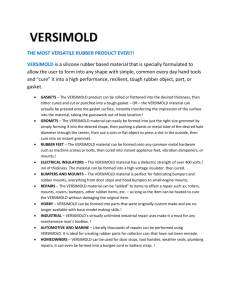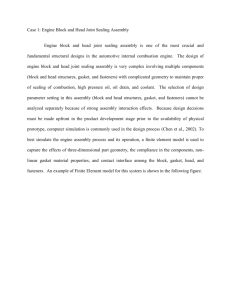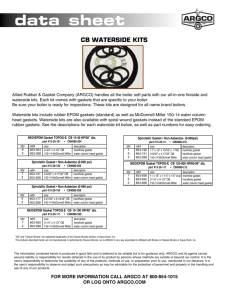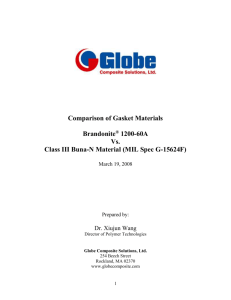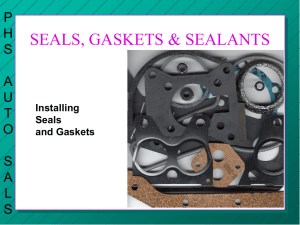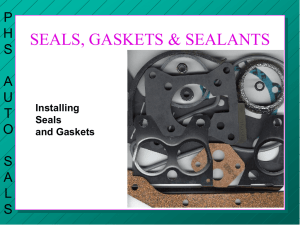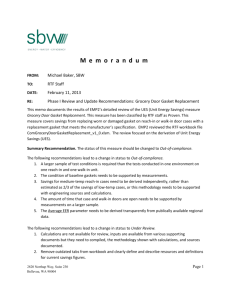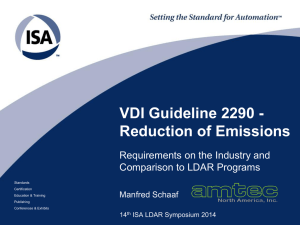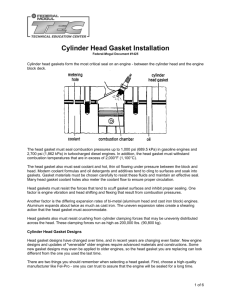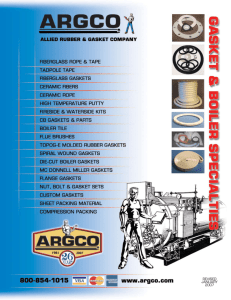Committee F03 History
advertisement
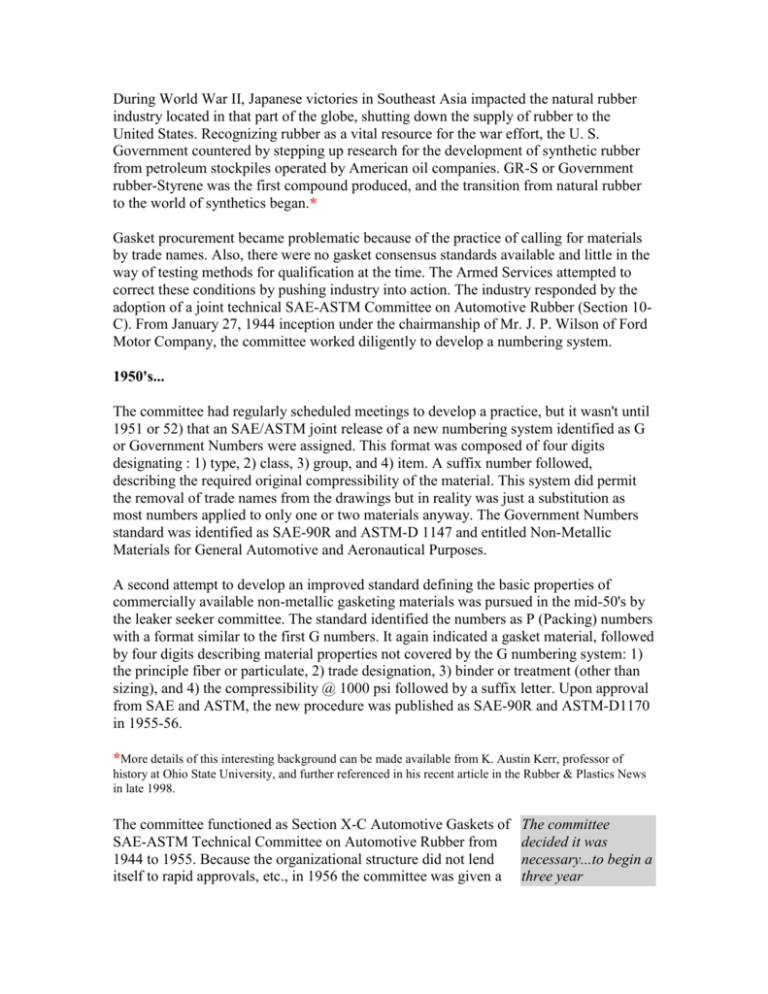
During World War II, Japanese victories in Southeast Asia impacted the natural rubber industry located in that part of the globe, shutting down the supply of rubber to the United States. Recognizing rubber as a vital resource for the war effort, the U. S. Government countered by stepping up research for the development of synthetic rubber from petroleum stockpiles operated by American oil companies. GR-S or Government rubber-Styrene was the first compound produced, and the transition from natural rubber to the world of synthetics began.* Gasket procurement became problematic because of the practice of calling for materials by trade names. Also, there were no gasket consensus standards available and little in the way of testing methods for qualification at the time. The Armed Services attempted to correct these conditions by pushing industry into action. The industry responded by the adoption of a joint technical SAE-ASTM Committee on Automotive Rubber (Section 10C). From January 27, 1944 inception under the chairmanship of Mr. J. P. Wilson of Ford Motor Company, the committee worked diligently to develop a numbering system. 1950's... The committee had regularly scheduled meetings to develop a practice, but it wasn't until 1951 or 52) that an SAE/ASTM joint release of a new numbering system identified as G or Government Numbers were assigned. This format was composed of four digits designating : 1) type, 2) class, 3) group, and 4) item. A suffix number followed, describing the required original compressibility of the material. This system did permit the removal of trade names from the drawings but in reality was just a substitution as most numbers applied to only one or two materials anyway. The Government Numbers standard was identified as SAE-90R and ASTM-D 1147 and entitled Non-Metallic Materials for General Automotive and Aeronautical Purposes. A second attempt to develop an improved standard defining the basic properties of commercially available non-metallic gasketing materials was pursued in the mid-50's by the leaker seeker committee. The standard identified the numbers as P (Packing) numbers with a format similar to the first G numbers. It again indicated a gasket material, followed by four digits describing material properties not covered by the G numbering system: 1) the principle fiber or particulate, 2) trade designation, 3) binder or treatment (other than sizing), and 4) the compressibility @ 1000 psi followed by a suffix letter. Upon approval from SAE and ASTM, the new procedure was published as SAE-90R and ASTM-D1170 in 1955-56. *More details of this interesting background can be made available from K. Austin Kerr, professor of history at Ohio State University, and further referenced in his recent article in the Rubber & Plastics News in late 1998. The committee functioned as Section X-C Automotive Gaskets of SAE-ASTM Technical Committee on Automotive Rubber from 1944 to 1955. Because the organizational structure did not lend itself to rapid approvals, etc., in 1956 the committee was given a The committee decided it was necessary...to begin a three year full section status under SAE as Section X. moratorium on the issuance of new material numbers until a third, improved numbering system could be developed. 1960's... In planning future work Section X determined that writing test procedures seemed to be the priority. Because of this, the group felt an additional change was necessary. Therefore on October 11, 1962 with the approvals of both SAE and ASTM, ASTM Committee F03 was born with its first chairman Ted Redman of Rochester Products, Division GMC. Once formed, the new committee once again reviewed industry needs. F03 found the P system was not working. The influx of new materials being put on the market created the same problem of having specific numbers for specific materials. The committee decided it was necessary to temporarily delay the writing of test procedures, and to begin a three year moratorium on the issuance of new numbers until a third, improved numbering system could be developed. Although development of a new numbering system was the top priority, writing of test procedures did not halt. Some of F03's most important and enduring test methods began development in the 1960s. In this era, the Caterpillar group gave the sealing industry a sharing of technology that, to this day, has had tremendous value in understanding gasket materials. The creep relaxation fixture and testing method has ultimately become one of the most important engineering tools the gasket industry has. This sharing principle - begun with Caterpillar's Lou Crystal, the 1966-70 chairman of the group - has become commonplace with the members of F03. 1970's.... F104 allowed either the producer or user of gasket materials to write individual specifications using a classification system, avoiding trade names. It took almost ten years to develop and agree to an open-ended system as a means of classifying gasket materials. The F104 Classification of Non-Metallic Gasket Materials was released in 1971. Willingness to work through pain and frustration, resulted in consensus. The end result was a true line call-out system designed such that both users and producers could tailor their own specifications. The design of this system was influenced by the ASTM D2000 standard format for rubber. Al Gordon of Vellumoid and Del Brown of Latex Fibers displayed The committee was endless energy in the development of F104. A host of others now poised and ready including Frank Phillips of the F. D. Farnam Company and George to develop test (High Swell) D'Olier of Raybestos-Manhattan were major procedures to keep up contributors. with the move from the art of gasket material selection to that of a distinct science of gasket material engineering. The committee was now poised and ready to develop test procedures to keep up with the move from the art of gasket material selection to that of a distinct science of gasket material engineering, primarily with the development of this open-ended classification system. Also, the dynamics of market demand, coupled with safety mandates including the reduction and elimination of harmful combustion components, carcinogen removal, and more stringent safety standards from the industrial sector produced profound changes in the matrices of materials. The backbone of the new classification system kept pace. The decade of the 70's ushered in challenges for the producers of gasket materials brought about by the needs of the users. The original Automotive orientated thrust was expanded to include Industrial gasket applications resulting in the continued growth of the new classification system. During this period the executive committee breakfast meeting times were changed. The new chairman, having an enormous appetite for getting things done, changed the starting time to 7:00am. Its members could no longer sleep in until an 8:30a.m. starting time. Executive committee members became known as the dawn patrol. We shall never forget Gerry Peck of Detroit Diesel, a Division of GMC, during his 1970-74 term of office. With the incorporation of the Industrial producer and user requirements, pioneered by B. G. Joe Staples of the Pfaudler Company of Rochester, New York, F03 test procedures expanded to include enveloped (preform) gaskets. Mr. Staples later became the F03 chairman for the 1976-80 term. 1980's... It became apparent to both the Automotive and Industrial F03 participants that the F104 classification system could not incorporate the newest gasket material innovations identified as composites. Recognizing this need, F03 pursued the development and eventual of a new classification system to resolve this problem. Under the leadership of G. F. Jerry Schmitt of Rochester Products Division of General Motors (1980-84), Henry Raub of Union Carbide (1984-86), and Frank Hagen of S.P.S. Laboratories (1986-90), Standard F 868 Classification on Laminated Composite Gasket Materials was published. The whiz kids of the 80's...took a bold step to...embrace a limitless number of composite variations and ideas and place them all within one classification Many of the existing test methods of F104 were directly applicable to F868, and were added as suffixes. The Whiz Kids of the 80's -- having learned from their predecessors how to write a classification system -- took a bold step to try and embrace a limitless number of composite variations and ideas and place them all within one classification system for Composite Gaskets however slanted toward automotive applications. 1990's... Under the highly structured leadership of Douglas Tracy (chairman 1992-96) discussions and work was initiated to now fill the void for yet a third classification system. The Industrial group of F03 has answered the call by forming a task force to come up with a classification system of its own, to be modeled to the F104 and F868 systems. The current chairman Mr. John Michna (1996 - present) of North America Sealing Systems Division of Federal-Mogul (the former Fel-Pro Incorporated became part of Federal-Mogul in February 1998) is steering the group to study functional behavior of gaskets, supplementing the established physical standards to build a bridge for life cycle prediction. The diversity of F03 membership embracing Transportation (includes automotive as well as heavy duty and of-highway) and Industrial interests, including producers, users, and general interest parties has stimulated broader knowledge seeking and activity. Testing methods and standards have begun to increase in number and technology. F03 is structured for the new millennium with representation from both Transportation and Industrial segments of interest. It also looks forward to international expansion and better efficiencies in writing standards using the electronic and internet advantages of today. F03 has maintained a membership of about 90 people for the past several years. This membership in 1999 has responsibility for 17 gasket test methods, three recommended practices (for evaluating various properties), two classification systems (one for nonmetallics, the other for composites or multilayer type materials), and one standard defining gasket terms. Summary... Gasket procurement problems with the United States Government during World War II started this long trek to the present. Old Section X-C of SAE/ASTM in 1944 evolved to Section X of SAE in 1956. With unfinished work for the proper noncommercial numbering system still remaining, and because of needed test procedures, SAE agreed this work should come under the direction of ASTM. Thus, in October of 1962 ASTM F03 was created. The committee succeeded: the original mandate was resolved. The evolution of the gasket industry brought about the need for additional classification systems and test procedures.
